Article Written by Duncan Burden
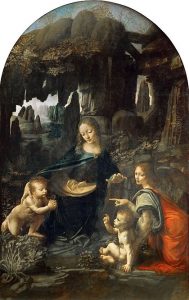 Since the Rennes le Château mystery and Dan Brown’s ‘The Da Vinci Code’ hit the public attention there has been a surge of interest and speculation of hidden meanings in art. Paintings such as Nicolas Poussin’s ‘Shepherds of Arcadia’ and Da Vinci’s ‘Last Supper’ have had countless theories revealing supposed hidden meanings in them. These include geometric patterns, symbolic positioning of characters, even encoded musical tunes. Some theories are more convincing than others; the work of such researchers as Lynn Picknett and Clive Prince, WILL make look twice at Da Vinci’s ‘Virgin on the Rocks’!
Since the Rennes le Château mystery and Dan Brown’s ‘The Da Vinci Code’ hit the public attention there has been a surge of interest and speculation of hidden meanings in art. Paintings such as Nicolas Poussin’s ‘Shepherds of Arcadia’ and Da Vinci’s ‘Last Supper’ have had countless theories revealing supposed hidden meanings in them. These include geometric patterns, symbolic positioning of characters, even encoded musical tunes. Some theories are more convincing than others; the work of such researchers as Lynn Picknett and Clive Prince, WILL make look twice at Da Vinci’s ‘Virgin on the Rocks’!
Even so, most of these theories leave the audience to reach their own conclusion as if any of these theories prove to be artistically intentional or not. Here though is a list of works which are already accepted as holding secret messages from the artist – some subtle, some blatant, some unanswered and some even hiding the art itself.
1)‘The Mona Lisa / La Gioconda’ – Leonardo Da Vinci
It would be impossible, and possibly disrespectful, not to include at least one Leonardo Da Vinci’s works on the list. This particular piece is possibly the most famous painting in the world. John Lichfield acknowledged it as being ‘the best known, the most visited, the most written about, the most sung about, the most parodied work of art in the world’, and it would be difficult to disagree with him.
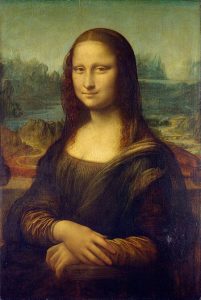 Various theories exist about possible hidden meanings within its composition. One of the favorites is that it is a self-portrait, with Leonardo depicting himself as a woman. In defense, questions have been raised over the artists sexual orientation, supported with his known interest in the geometric proportions of the human body, it is possible he was ‘playing’ with the idea of presenting himself in the perfect geometric proportion, that of a hermaphrodite.
Various theories exist about possible hidden meanings within its composition. One of the favorites is that it is a self-portrait, with Leonardo depicting himself as a woman. In defense, questions have been raised over the artists sexual orientation, supported with his known interest in the geometric proportions of the human body, it is possible he was ‘playing’ with the idea of presenting himself in the perfect geometric proportion, that of a hermaphrodite.
Yet this painting is included in the list due to a discovery made by the National Committee for Cultural Heritage of Italy. When the work was viewed under a microscope, the letters ‘LV’ where seen to be visible in figure’s dominate eye, which had never been noticed before. The letters could simply be Leonardo’s own initials. If so, could it confirm that this is a self-portrait?
It could also be possible that Leonardo was creating a visual pun; that he was metaphorically showing himself in the reflection of the figure’s eyes – by putting his initials there. As such, could it also be a subtle romantic reference between lady and himself? Possibly, as this painting was meant to be Leonardo’s favorite, and the singular work of art he is meant to have taken with him on his travels. I wonder if he was trying to say ‘beauty is in the eye of the beholder’ – if so, what, or whom, did he mean the beauty to be?
The same research identified another unknown element; that on bridge situated in the background, the number ‘72’, or possibly a ‘L2’, is visible in the arch. If it is indeed ‘72’ could this refer to 72 degrees? 72 degrees is the fundamental number used to build a pentagon; the geometric shape that classical artists believed structured the human body, of which a hermaphrodite body was meant to be the perfect form to compliment it.
2)‘David’ – Michelangelo
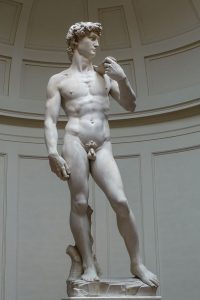 Just to show that secret elements of art are not just found in paintings, here is a stunning example found in a sculpture. Michelangelo was only 26 years old when he began this statue in 1501 and it took him just over two years to complete. The statue was originally commissioned to be one of a collection of similar works that were to be placed along the roofline of the east end of Florence Cathedral. Instead this work came to be positioned in the public square, outside the Palazzo Vecchio, the seat of the civic government of the city.
Just to show that secret elements of art are not just found in paintings, here is a stunning example found in a sculpture. Michelangelo was only 26 years old when he began this statue in 1501 and it took him just over two years to complete. The statue was originally commissioned to be one of a collection of similar works that were to be placed along the roofline of the east end of Florence Cathedral. Instead this work came to be positioned in the public square, outside the Palazzo Vecchio, the seat of the civic government of the city.
Because of the story Biblical David, and because the statue was meant to show the character literally before his conflict with the giant Goliath, the work came to represent the city’s defiance against the various neighboring powerful states. To highlight this, the statue was even set so that it faced Florence’s greatest threat; the city of Rome, symbolically facing their David against the giant force of the Roman power machine.
This depiction of David stood an incredible 5.17 metres (17 foot) tall, and it is this scale that Michelangelo used to convey a secret alternative representation of the character. Michelangelo knew that the audience’s view point would always be from the ground looking up. Even from a distance, the scale of the work insured that the perspective would be from below, and it would be only if someone had the rare chance of standing face to face with the character that they could see the direct facial features. This understanding Michelangelo used to great effect.
From the ground David appears strong confident, yet if the chance is given to look at him straight in the face, his features convey genuine concern, anger, almost fear in his predicament – a very real face for someone armed with only a sling set to fight a giant of a seasoned warrior named Goliath. This statues shows one of the greatest examples of an artist using perspective to add deeper meaning to their work. I wonder if he ever thought the secret would be revealed – if so when?
3)‘The Ambassadors’ – Hans Holbein the Younger
 Another incredible example of understanding the perspective of an audience would be this work by the 16th century German artist, Hans Holbein the Younger. Those already interested in secret messages in art would already be aware of this famous painting and its obscure blob that appears to be wiped across the bottom, but its significance is worth discussing.
Another incredible example of understanding the perspective of an audience would be this work by the 16th century German artist, Hans Holbein the Younger. Those already interested in secret messages in art would already be aware of this famous painting and its obscure blob that appears to be wiped across the bottom, but its significance is worth discussing.
An alternative name for this painting is ‘Jean de Dinteville and Georges de Selve’, which are the names of the two characters portrayed. The work is really a double portrait but with a strong element of ‘still life’ included. It was completed in 1533 and the ‘still life’ element refers to the meticulously arranged items that are visible on the tables between the characters. There has been extensive debate over of the reasoning of the items, but generally it is believed that they are meant to represent how educated the characters were in the various liberal arts shown. Interestingly, this work is credited with the earliest known representation of a globe.
Yet, the work is mostly famous for its use of anamorphosis. Anamorphosis is when an image can only be seen if the audience has to use a special device or has to look at the image from a unique perspective. In this case, Hans painted a human skull, (the blob), in such a way that it could only be recognized if viewed from virtually directly adjacent to the work.
The use of skull in a work of art, especially in the Renaissance period, was to convey Latin phrases like ‘memento mori,’ which means ‘remember you shall die.’ The idea that the symbol of death is obscure is to follow the common theme that the risk of death is never far away and is always present when we least aware. This concept was used in art to remind people of their moral obligations, that death could come at any time, therefore you needed to achieve what you will and be mindful to be moral in every moment, as you cannot atone for your sins after death.
4)‘Proverbs’ – Pieter Bruegel the Elder
If any painting was meant to represent a thousand words then the Dutch artist, Pieter Bruegel the Elder, certainly accomplished it with his work ‘Netherlandish Proverbs.’ Other names have been attributed to this work, such as ‘The Blue Cloak’ and ‘The Folly of the World’, but ‘Netherlandish Proverbs’ is the most recognized.
This oil on oak painting was completed in 1559, and is said to contain at least 112 proverbs, or sayings, that were used in the common vernacular at the time, many of which are still in use today. There are several different versions of this work, or similar depictions, mostly composed by Pieter Bruegel the younger (the son of the artist), but this was the first.
Although it could be argued that this work doesn’t really convey a secret specifically, it does offer the audience an immediate challenge to take in all its intentional meaning. Can you find all the messages? Here are some to get you going. Can you find the man running with his rear on fire? (Depicting ‘run like your bottoms is on fire’). How about finding three figures standing in a line? (Depicting ‘the blind leading the blind’). Where is there a fish eating another fish? (Depicting ‘there is always a bigger fish’). A man is holding a globe? (Depicting ‘You have the world in the palm of your hand’). A knight in Armour holding a knife in his mouth? (Depicting ‘Being armed to the teeth’). How about a man is hitting his head against a brick wall? (Depicting ‘Hitting your head against the wall’). A man swimming hard against the river? (Depicting ‘Swimming against the tide’).
You now just have another 105 to go. Good luck.
5)The Garden of Earthly Delights’ – Hieronymus Bosch
Hieronymus Bosch, like his fellow Dutch artist – Pieter Bruegel the Elder, is known for abstract art. His work is often comprising of a host of detailed images of people and characters all entwining in depicted scenes. Indeed, Pieter Bruegel the Elder was known to be an admiring follower of Bosch’s work and style, which is evident when you review both artist’s works.
Like most artists on this list, Bosch’s work is incredibly famous, especially with his depictions of hell. Art scholars have for reviewed his work for centuries, and have come to recognize that his macabre sense of understanding human fears of divine judgement and of an eternity of punishment in hell, are perfectly represented in his work.
His most prominent works are his commissioned altarpieces, most significantly one entitled ‘The Garden of Earthly Delights’, believed to be completed between 1495 and 1505. The work depicts three scenes, heaven, earth and hell. In the latter scene there are various wild images, mostly scary representations of demons and methods of torture for the damned. It is in this work that a secret was found.
This secret wasn’t discovered by any specialist, but an innocent blogger named ‘Amelia’ who posted on her Tumblr account that she had found some hidden musical notes in the painting. Indeed, in one of the small images of the depictions of hell, Amelia noticed that a sheet of music could be seen, and below it was more music written on a human bottom. This was assumed, or accepted, to have been just a randomly image of music, with no more significance than showing the indignity of the poor character bent over and having a demon play the tune. Actually the notes proved not to be random and a coherent tune could be played, now called the ‘Sinner’s Hymn’.
6)‘Bacchus’ – Michelangelo Merisi da Caravaggio
 Caravaggio is possibly the most controversial artist in history, with regard to his life story. He began his life as a painter in Milan, but then moved to Rome in his twenties. Although he was quickly regarded as a highly talented artist, he was equally renowned to be an aggressive character, often provoking others, being easily offended and as easily ready to fight. It was due to fight that led to him being sentenced to death for murder and forcing him to escape to Naples.
Caravaggio is possibly the most controversial artist in history, with regard to his life story. He began his life as a painter in Milan, but then moved to Rome in his twenties. Although he was quickly regarded as a highly talented artist, he was equally renowned to be an aggressive character, often provoking others, being easily offended and as easily ready to fight. It was due to fight that led to him being sentenced to death for murder and forcing him to escape to Naples.
He eventually returned to Naples in 1609, whilst seeking a pardon from the Vatican, but he again got into a violent confrontation which left his face disfigured. He died the following year, whilst on a journey back to Rome, but rumors circulated before then. It has never been truly established how he died. Was he murdered, die of his injuries, or did he take his own life? One assumption has been proposed that his violent behavior was due to lead poisoning, possibly due to his own paints, and the poisoning eventually killed him. Such turbulent lives are often linked to the consumption of alcohol, especially wine, which brings us to Caravaggio’s own depiction of ‘Bacchus’, finished in around 1595.
‘Bacchus’ was a common mythical character depicted throughout the Renaissance, even towards its end. He was the Greek god of wine, so the versatility of how to use the character to convey a meaning, or tone, in a painting is easy to appreciate. Indeed, at first glance, Caravaggio depiction of the lesser Greek god, would seem a standard, although skilled, representation. It is presented in the style of a portrait, with the character relaxing with the symbols of his authority; namely a bunch of grapes and a carafe of wine, but there is more to this seemingly innocent picture. Caravaggio’s secret inclusion was not found for another 300 years, when, in 1922, a restorer spotted a small image depicted in the carafe of wine – it was a miniature, almost invisible, self-portrait of Caraviggio himself, aged in his mid-twenties.
It was not until 2009 when researchers, using a technique called reflectography, managed to investigate the image further. From their research it was concluded that it was unlikely Caravaggio was attempting to represent himself as ‘being lost in the intoxication of Bacchus’, but rather he was secretly showing his skill as a painter and included his own reflection in the glass of the carafe, from the perspective of the artist painting the scene. Indeed, his depiction could be a mixture of both.
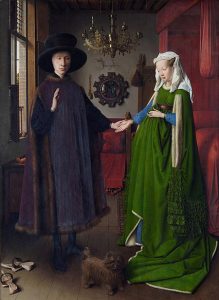 7) ‘The Arnolfini Portrait’ – Jan van Eyck
7) ‘The Arnolfini Portrait’ – Jan van Eyck
‘The Andolfini Portrait’ is the ‘Shepherds of Arcadia’ of the academic world, as being one of the most debated paintings ever composed. Various academics have offered explanations and theories about some of the strange details of the composition, from the sandals, to the presentation of the dog, even to the delicate positioning of the woman’s hands, but its secret is similar in nature to that of Caravaggio’s ‘Bacchus.’
The painting is the work of another Dutch painter, a Jan van Eyck, and is believed to be of an Italian merchant named Giovanni di Nicolao Arnolfini and his wife. The work was completed in 1434, and that assumption of this is part of the secret contained within it.
The attraction of the work has been the apparent casual, therefore, more realistic depiction of 15th century life, but uniqueness is that it appears to be a commissioned portrait. Commissioned portraits were expensive and would not be expected to reflect a casual moment. Instead a portrait would normally portray how the characters wished to be remembered or wished to be seen. Instead, this painting holds images of sandals being left in view as if just discarded, a bed is clearly depicted on the right hand side and dog is placed looking straight to the audience. There is also an assumption that the lady is pregnant, but the general academic opinion is that she is just wearing the fashion of the period, which again conveys a real moment of history, rather than the standard portrait designed for posterity.
Yet is it the circular convex mirror on the wall that adds depth to the quality of the work, as it contains subtle message from the artist.
We can recognize it as a mirror, as it shows a reflection of two additional figures standing beside the doorway, but the images is distorted in exactly the way a convex mirror would do. One of the figures is assumed to be the artist himself, but who is the other person? It is unknown if van Eyck used a real convex mirror to paint the scene from behind, but the curved distortions of the image are almost optically perfect. Interestingly the mirror also has a motto written around the frame which reads; ‘Johannes de eyck fuit hic 1434’ – ‘Jan van Eyck was here 1434’!
8) ‘Perseus with the Head of Medusa’ – Benvenuto Cellini
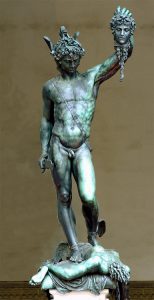 This is the second sculpture to make the list, and its inclusion is for a similar reason to that of Michelangelo’s ‘David’. Unlike Michelangelo’s statue which craved from marble, Cellini’s work was cast from bronze.
This is the second sculpture to make the list, and its inclusion is for a similar reason to that of Michelangelo’s ‘David’. Unlike Michelangelo’s statue which craved from marble, Cellini’s work was cast from bronze.
Benvenuto Cellini was an Italian artist, famous not just for his skill as a sculptor, but was also noted for his ability as a goldsmith, draftsman, musician and as a writer; having written a famous autobiography and renowned poetry. Yet his fame as a leading figure in the artistic style of ‘mannerisim’ is clearly expressed in this work ‘Perseus with the Head of Medusa.’
The work is believed to have been completed between 1545 and 1554, and was commissioned by the second Florentine duke, Duke Cosimo I de’ Medici. It was erected on 27 April 1554, at the Piazza della Signoria in Florance, where already stood Michelangelo’s ‘David’, Bandinelli’s ‘Hercules and Cacus’ and Donatello’s ‘Judith and Holofernes’.
The sculpture is around 5 metres tall, which includes the height of its square base. Uniquely, the base is another reason this work holds a noted place in history, as the base is the first of its kind since the classical period. The unique quality is that the base forms an integral part of the design, as it depicts scenes from the Perseus story, thus supporting the primary image not just physically but also through the imagery.
The primary design of the statue is clearly the immediate moment following Perseus cutting Medusa’s head from her body, as not only is he holding her head aloft but her twisted body can still be seen at his feet.
The secret of this statue, like Michelangelo’s ‘David’, relates to double faces and perspective, but also includes the concept of an artist’s self-portrait (a common theme in the list). Cellini was aware that the expected view of his statue would be the front, so he took the advantage and used the back of Perseus head to hide another encrypted face – his own. Using the back of the hero’s helmet, framing the view by the wings attached and crafting the hair, Cellini managed to create a self-portrait for posterity.
9)‘Bonnie Prince Charlie’ – Artist Unknown
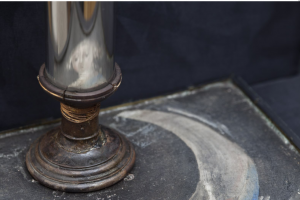 In all the examples so far, the primary motivation of the secret element has been artistic vanity, an opportunity to show the skill or a chance to add an additional emotive value to the work. The following example is when the art work has had to be so perfectly encrypted simply because the ownership of it would have meant death.
In all the examples so far, the primary motivation of the secret element has been artistic vanity, an opportunity to show the skill or a chance to add an additional emotive value to the work. The following example is when the art work has had to be so perfectly encrypted simply because the ownership of it would have meant death.
This example is the alternative, and more challenging version, of anamorphic art, where a special optical device is needed to see the work itself. In this case a mirrored tube is required to really see the image.
The artist of this work is unknown, but can be found at West Highland Museum in Scotland. It is not on a wall, nor was it meant to be openly displayed, for if it was it could have drawn attention and had the owner arrested. Instead an innocent swirling pattern is painted on an ordinary wooden tray. The design seems slightly arched, and if a mirrored tube is placed in the corner of that arch, the audience could see a stunning portrait of Bonnie Prince Charlie in the reflection.
Why would it be a criminal offence?
Charles Edward Louis John Casmir Sylvester Severino Maria Stuart (Bonnie Prince Charlie) was the elder son of James Francis Edward Stuart and grandson of James II and James the VII. In 1745 he was instrumental in an uprising to claim the throne, but the revolt ended with their loss at the Battle of Culloden. Any supporters of the Stuarts were heavily persecuted, and were tried on the grounds of treason. As such, many families could only hold their devotions secretly, and resulted in amazing secret works of art hidden in plain sight on an ordinary tray.
10)‘The Creation of Adam’ – Michelangelo
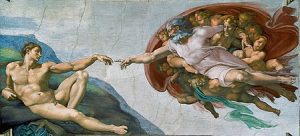 Michelangelo is the only artist to achieve two entries on the list; the first was his statue of David and his second being part of his famous ceiling painting at the Sistine Chapel.
Michelangelo is the only artist to achieve two entries on the list; the first was his statue of David and his second being part of his famous ceiling painting at the Sistine Chapel.
Michelangelo, like Leonardo Da Vinci, could be seen both as a genius and an artistically skilled individual. Also like Da Vinci, he could be recognized as epitomizing the Renaissance agenda in mixing seeking, and understanding, intellectual ideals and presenting them artistically. He has already been proven as accomplished sculptor, but he was also skilled architect and his paintings are renowned for their anatomic precision.
His skill in the latter was due to the fact that during his youth he dissected corpses from graveyards to understand the design and structure of the human body. It has strongly been argued that his intimate knowledge of the shape of inner organs was reflected in his work, often to make an addition emphasis to a painting. Such a subtle, but meaningful, use of this method can be found in his famous depiction of ‘The Creation of Adam’ on the ceiling of the Sistine Chapel.
In the famous scene, Adam is laid back with his outstretched hand towards the pointing finger of God. God is equally leaning forward, seemingly giving the spark of life/creation to Adam. Even at that time, God being depicted as a human figure was rare, even unheard of. Still, Michelangelo gave an even more controversial idea in his art that seemed to go unnoticed for centuries.
He depicted Adam, expectedly, sitting on a grassy hill, yet the figure of God is not drifting in a Zeus like cloud, or anything that resembles heaven. Instead the assumed image of God is surrounded by twelve figures strangely drifting in a pink cape or blanket. In addition, unlike the common artistic depiction of a cape, all the edges are in the foreground and the fabric billows back behind the figures, almost like a parachute working sideways. It almost gives a shell-like room in which the characters seem to be seated. Also, the color of the fabric is flesh-toned. If an audience outlines the cape, it is revealed that it holds the correct anatomical shape of a dissected brain!
The notion of accepting the link between the intellect and brain was still in its intellectual infancy when this painting was composed and was possibly even an element the church would have stood against the scientific fact. Yet, it appears clear that Michelangelo hid in plain sight of the clergy who commissioned his work, the beautiful metaphoric representation of God’s intellect. Perhaps the old man, is not God, but just one of the multiple divine creatures that are represented in the cloak – that Michelangelo knew the audience would suppose the old man was a depiction of God, when really he was using the image of the robe, the subtle picture of a brain, to represent his real representation of God, the Grand Intellect behind creation – literally and artistically.
~Article written by Duncan Burden
Duncan Burden enjoys researching history. Although he often writes on Masonic issues, since he has been a Freemason for most of his adult life and is a member of various Masonic bodies, such as the Royal and Select Master Masons, and Operative Masons, he takes pleasure in writing on all historic, mysterious, and exciting topics.
He was born on the Norfolk Coast, and now lives in Hertfordshire, England.
Best of luck with all that you seek! Always Treasure the Adventure!

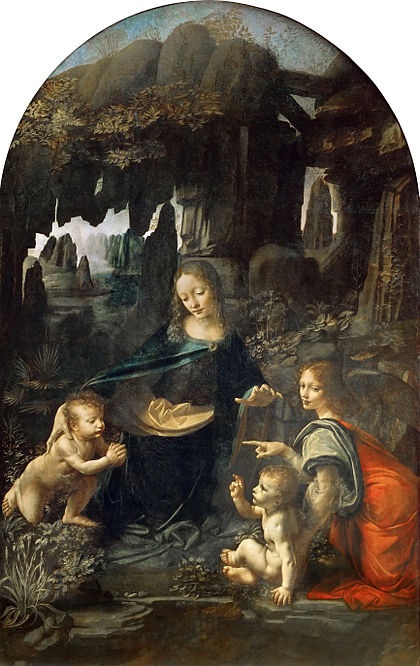
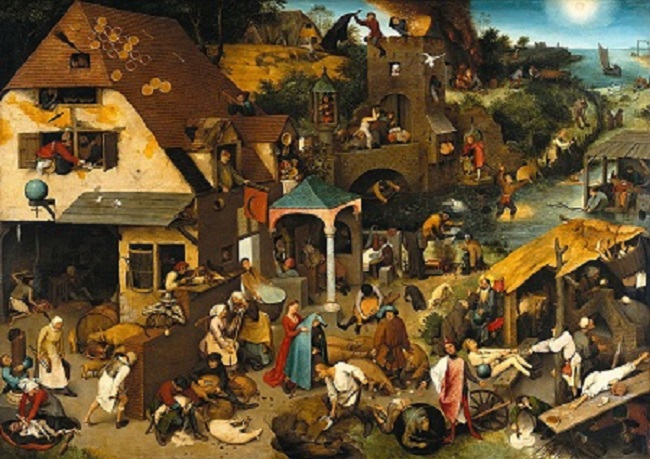
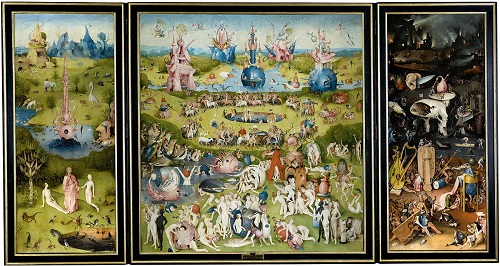
Thank you Jenny! I really enjoyed this and learned quite a few new things that I didn’t know.
Nice took me back to the Maranatha Days. I have since been lucky enough to be in the presence of some of the works
Thank you for the informative post, Jenny.